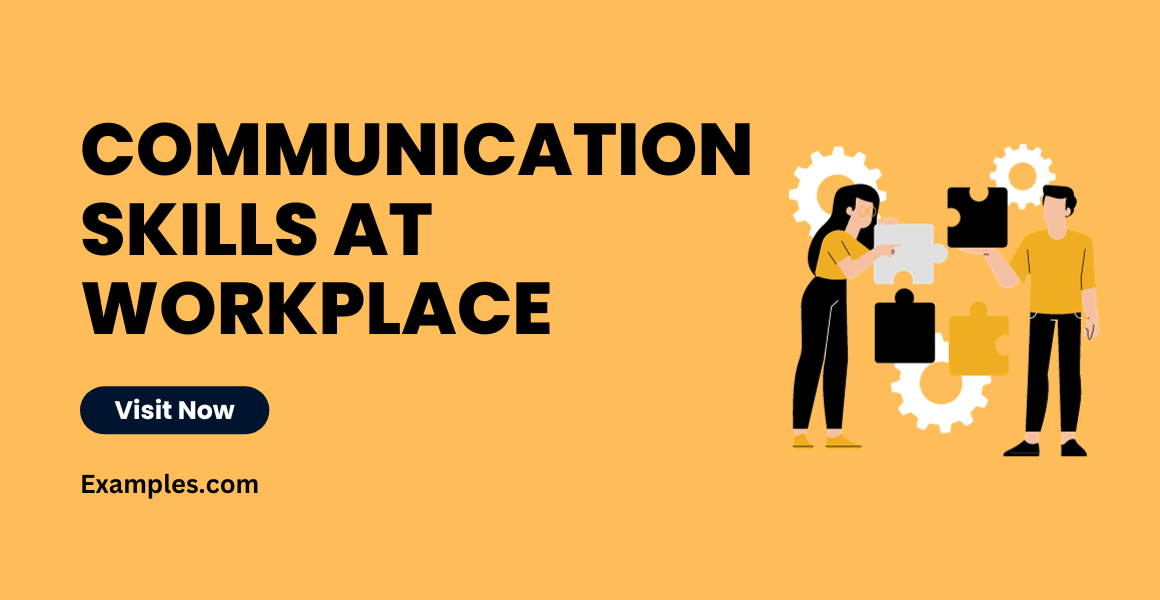29+ Communication Skills at Workplace Examples
Effective communication skills are essential in the workplace to foster a productive, collaborative, and positive work environment. This comprehensive guide explores the key aspects of workplace communication, offering insightful communication examples and practical tips. From mastering verbal and non-verbal interactions to navigating digital communication channels, learn how to effectively convey ideas, resolve conflicts, and build strong professional relationships. Enhance your professional skillset with strategies that lead to successful teamwork, leadership, and overall workplace efficiency.
30 Communication Skills at Workplace Examples
Effective communication in the workplace is crucial for collaboration, productivity, and maintaining a positive work environment. This guide presents 30 distinct examples of communication skills applied in various workplace scenarios. Each example demonstrates practical applications of key communication techniques, ranging from daily interactions to handling complex situations. These examples highlight the importance of clear, respectful, and effective communication in fostering a cooperative and efficient professional atmosphere.
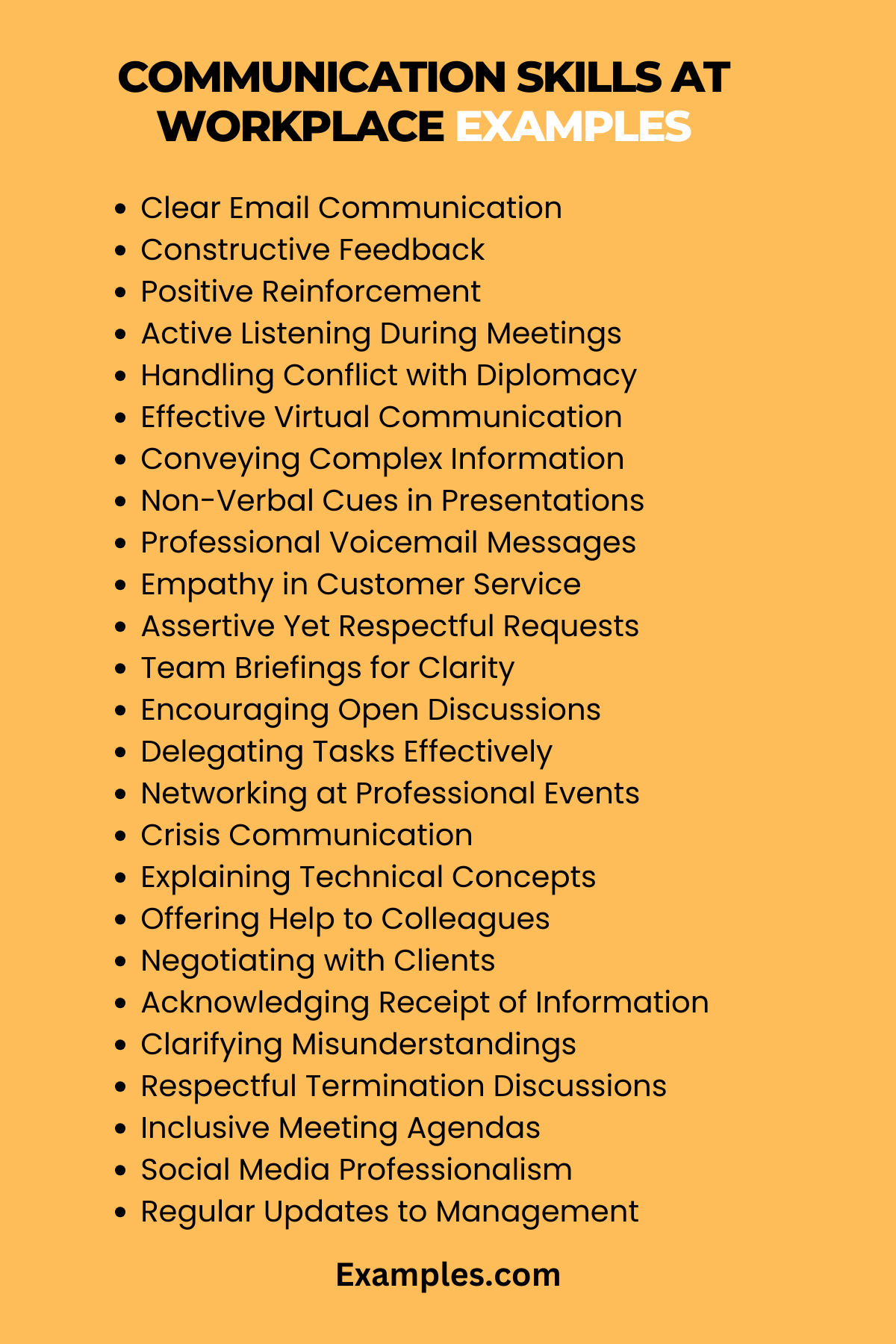
- Active Listening During Meetings: “I hear your concerns about the project timeline, let’s explore potential solutions together.”
Demonstrates attentive listening and collaborative problem-solving in meetings. - Clear Email Communication: “Please find attached the report for Q1. Let me know if you need further details.”
Exhibits clarity and conciseness in email correspondence. - Constructive Feedback: “Your presentation had great content, but let’s work on making your delivery more engaging.”
Provides specific and helpful feedback for improvement. - Positive Reinforcement: “Great job on the recent project! Your attention to detail really made a difference.”
Uses encouragement to motivate and acknowledge good work. - Handling Conflict with Diplomacy: “I understand both perspectives, let’s find a compromise that works for everyone.”
Shows mediation skills in resolving workplace disputes. - Effective Virtual Communication: “Let’s ensure everyone’s camera is on for better engagement during our virtual meeting.”
Encourages active participation in remote communication settings. - Conveying Complex Information: “To clarify the process, I’ve broken it down into these key steps…”
Simplifies complex information for easier understanding. - Non-Verbal Cues in Presentations: Using open gestures and maintaining eye contact while presenting to engage the audience.
Enhances verbal communication with effective body language. - Professional Voicemail Messages: “You’ve reached [Your Name]. Please leave a message, and I’ll get back to you promptly.”
Exhibits professionalism in voicemail communications. - Empathy in Customer Service: “I understand why that issue would be frustrating; let’s see how I can help.”
Shows understanding and readiness to assist in customer service. - Assertive Yet Respectful Requests: “I would appreciate it if we could prioritize this task due to its urgency.”
Communicates needs assertively without being aggressive. - Team Briefings for Clarity: “For this project, here are the roles and expectations for each team member.”
Provides clear instructions and expectations in team settings. - Encouraging Open Discussions: “I’d love to hear everyone’s ideas on how we can improve this process.”
Fosters an open and inclusive environment for ideas. - Delegating Tasks Effectively: “John, could you take the lead on the research part? Your expertise would be valuable here.”
Shows clear and thoughtful task delegation. - Networking at Professional Events: “I enjoyed your talk on innovation. Could we discuss your insights over coffee?”
Demonstrates networking skills with a polite and genuine approach. - Crisis Communication: “In light of the situation, here’s the action plan to mitigate the impact effectively.”
Exhibits calm and clear communication during crises.
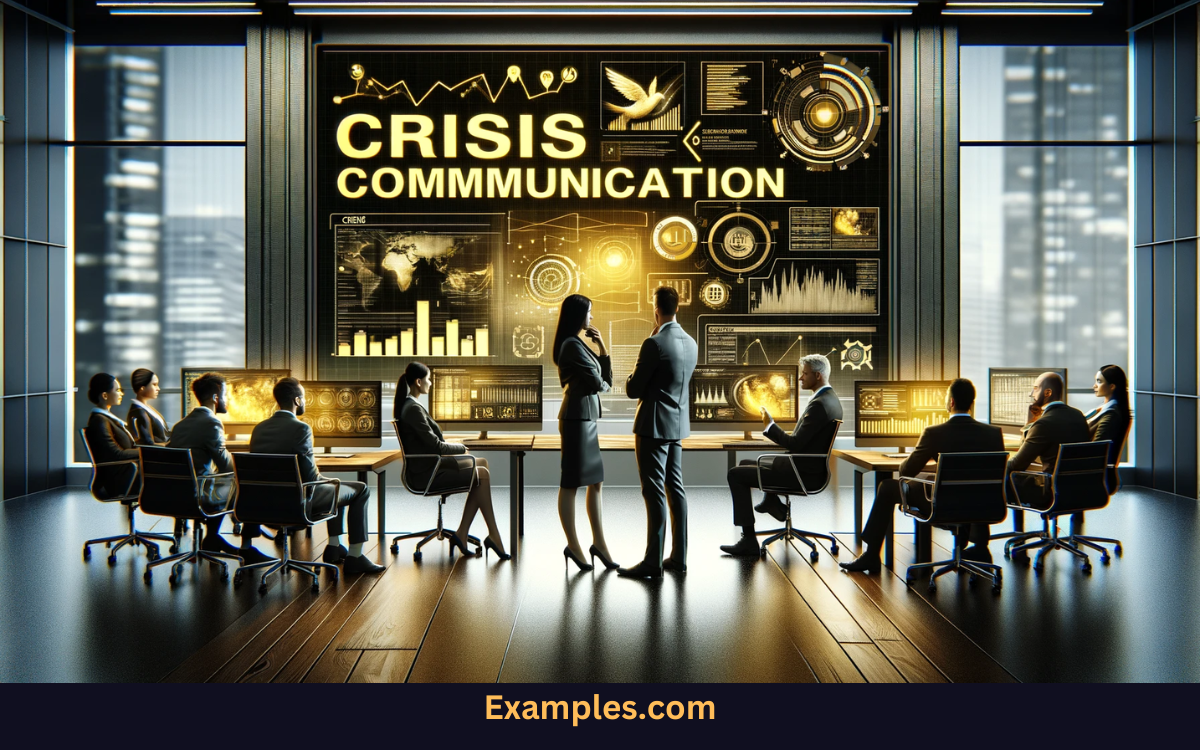
- Explaining Technical Concepts: “To put it simply, the new software helps automate our existing manual process.”
Breaks down technical jargon for a non-technical audience. - Offering Help to Colleagues: “I noticed you’re working late on the project. Can I assist you with anything?”
Shows willingness to support and collaborate with colleagues. - Negotiating with Clients: “I understand your budget constraints. Let’s find a solution that meets our mutual interests.”
Balances firmness and flexibility in client negotiations. - Acknowledging Receipt of Information: “Thank you for sending the documents. I will review them and respond by tomorrow.”
Confirms receipt and provides a timeline for further action. - Clarifying Misunderstandings: “To avoid confusion, let me clarify what I meant by those remarks.”
Addresses and rectifies misunderstandings promptly.
- Respectful Termination Discussions: “We value your contributions, but we have to make tough decisions for the company’s future.”
Handles sensitive conversations with respect and empathy. - Inclusive Meeting Agendas: “Let’s ensure everyone has a chance to speak in the meeting today.”
Promotes inclusivity and equal participation in meetings.
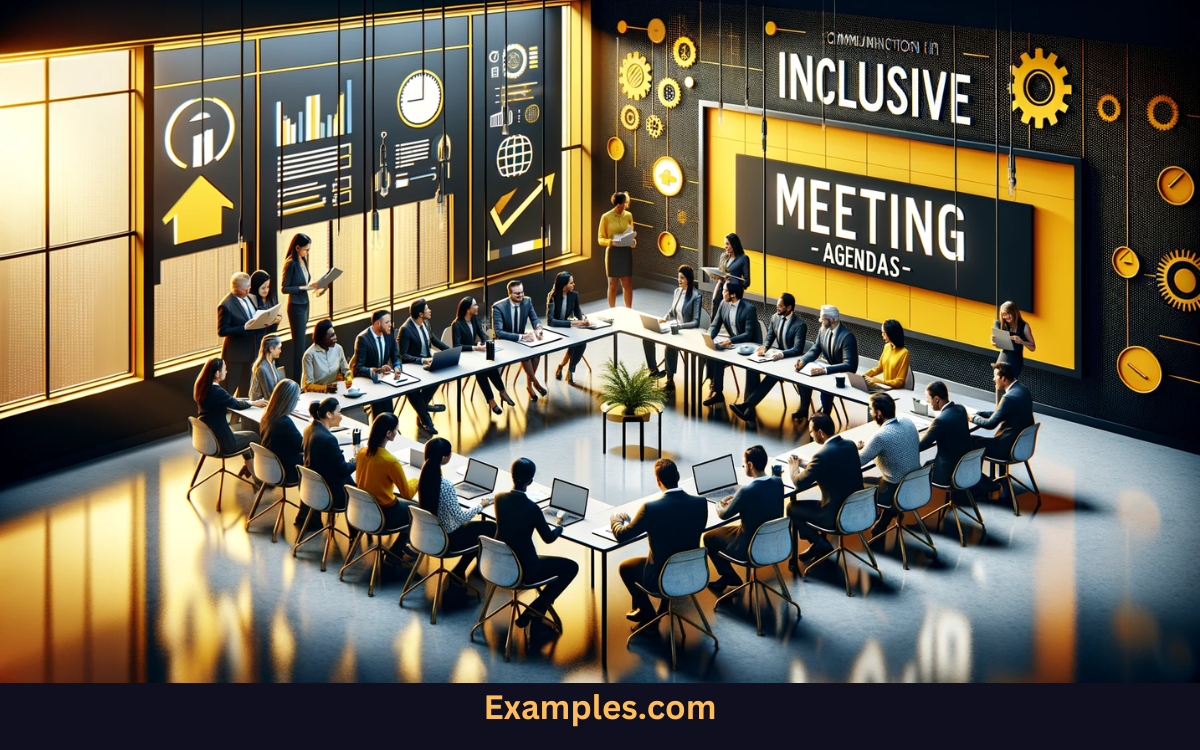
- Social Media Professionalism: Posting relevant industry articles with thoughtful insights on LinkedIn to engage the professional network.
Uses social media to share knowledge and build a professional brand.
- Regular Updates to Management: “Here’s a weekly update on my project’s progress and next steps.”
Keeps management informed with regular updates. - Mentoring Junior Staff: “Let me show you how I handle these tasks; it might give you some ideas.”
Guides and supports less experienced colleagues.
- Receiving Feedback Graciously: “Thank you for the feedback; I’ll work on those areas to improve.”
Demonstrates openness to learning and self-improvement. - Cross-Cultural Communication Sensitivity: “I’m aware of the cultural differences, so I’ll approach this matter sensitively.”
Shows awareness and respect for cultural diversity. - Communication During Change Management: “As we transition, I’ll keep everyone updated and address any concerns you might have.”
Effectively communicates during organizational changes. - After-Action Reviews for Learning: “Let’s discuss what went well and what we can improve for next time.”
Uses reflective practices to learn and grow from experiences.
What are Effective Communication Skills at Workplace?
Effective communication skills at the workplace are a set of abilities that enable individuals to convey, receive, and interpret ideas, information, and feelings in a clear, concise, and respectful manner. These skills are crucial for fostering collaboration, enhancing team dynamics, and ensuring smooth operations within any professional setting. They encompass various forms of interaction, including verbal, non-verbal, written, and digital communication.

Here’s a guide to understanding and developing these essential skills.
Verbal Communication
- Clarity and Conciseness: Speak clearly and directly to effectively convey your message without causing confusion.
- Active Listening: Listen attentively to understand others’ viewpoints, showing that you value their input.
Non-Verbal Communication
- Body Language: Use appropriate gestures, facial expressions, and posture to reinforce your verbal messages.
- Eye Contact: Maintain appropriate eye contact to demonstrate engagement and sincerity.
Written Communication
- Professional Tone: Use a professional and polite tone in all written correspondence, including emails and reports.
- Clear Structure: Organize your written communication logically, making it easy to follow and understand.
Digital Communication
- Email Etiquette: Adhere to professional standards in email communication, including clear subject lines and concise content.
- Virtual Meeting Etiquette: Participate effectively in virtual meetings with proper preparation and active engagement.
Empathy and Understanding
- Empathetic Responses: Show empathy towards your colleagues’ situations and viewpoints.
- Cultural Sensitivity: Be aware of and respectful towards cultural differences in communication styles.
Assertiveness
- Confident Expression: Communicate your ideas and opinions confidently without being aggressive.
- Respectful Assertiveness: Be firm in your assertions while respecting others’ opinions and boundaries.
Conflict Resolution
- Problem-Solving Approach: Address conflicts with a focus on finding solutions rather than assigning blame.
- Mediation Skills: Facilitate discussions to resolve misunderstandings and disagreements amicably.
Feedback
- Constructive Feedback: Provide feedback that is specific, constructive, and aimed at improvement.
- Receiving Feedback: Accept and reflect on feedback gracefully for personal and professional growth.
Adaptability
- Flexible Communication: Adapt your communication style to suit different situations and audiences.
- Openness to Change: Embrace changes in communication methods and workplace dynamics.
Continuous Improvement
- Self-Reflection: Regularly reflect on your communication skills and seek areas for improvement.
- Professional Development: Engage in ongoing learning and training to enhance your communication abilities.
By mastering these communication skills, individuals can significantly contribute to a positive and productive work environment, leading to enhanced team collaboration, better problem-solving, and stronger professional relationships. These skills are fundamental for career advancement and success in any workplace.
Why are Communication Skills Important in the Workplace?
Effective communication skills are vital in the workplace as they significantly contribute to a harmonious and productive work environment. Understanding the importance of these skills can lead to better team dynamics, increased efficiency, and improved overall job satisfaction.

Enhancing Team Collaboration
- Fosters Teamwork: Clear and open communication builds a sense of teamwork and cooperation among colleagues.
- Resolves Misunderstandings: Prompt and effective communication helps in resolving misunderstandings, thereby avoiding conflicts.
Boosting Productivity and Efficiency
- Streamlines Processes: Efficient communication ensures that information is conveyed accurately, leading to streamlined work processes.
- Reduces Errors: Clear instructions and feedback minimize the likelihood of errors and misunderstandings in tasks.
Improving Employee Engagement and Morale
- Increases Job Satisfaction: Employees who feel heard and understood are more likely to be satisfied with their jobs.
- Encourages Employee Participation: Open communication channels encourage employees to voice their ideas and opinions, fostering a sense of belonging.
Aiding in Conflict Resolution
- Resolves Issues Constructively: Effective communication is key to resolving workplace conflicts in a constructive manner.
- Promotes Understanding: Understanding differing viewpoints through communication can lead to amicable solutions.
Enhancing Professional Growth
- Builds Leadership Skills: Strong communication skills are essential for effective leadership and management.
- Facilitates Career Advancement: Employees with excellent communication skills are often considered for promotions and leadership roles.
What are Types of Communication Skills in the Workplace?
There are various types of communication in the workplace, each playing a crucial role in daily operations and interactions. Understanding these types can help enhance effectiveness and workplace relationships.
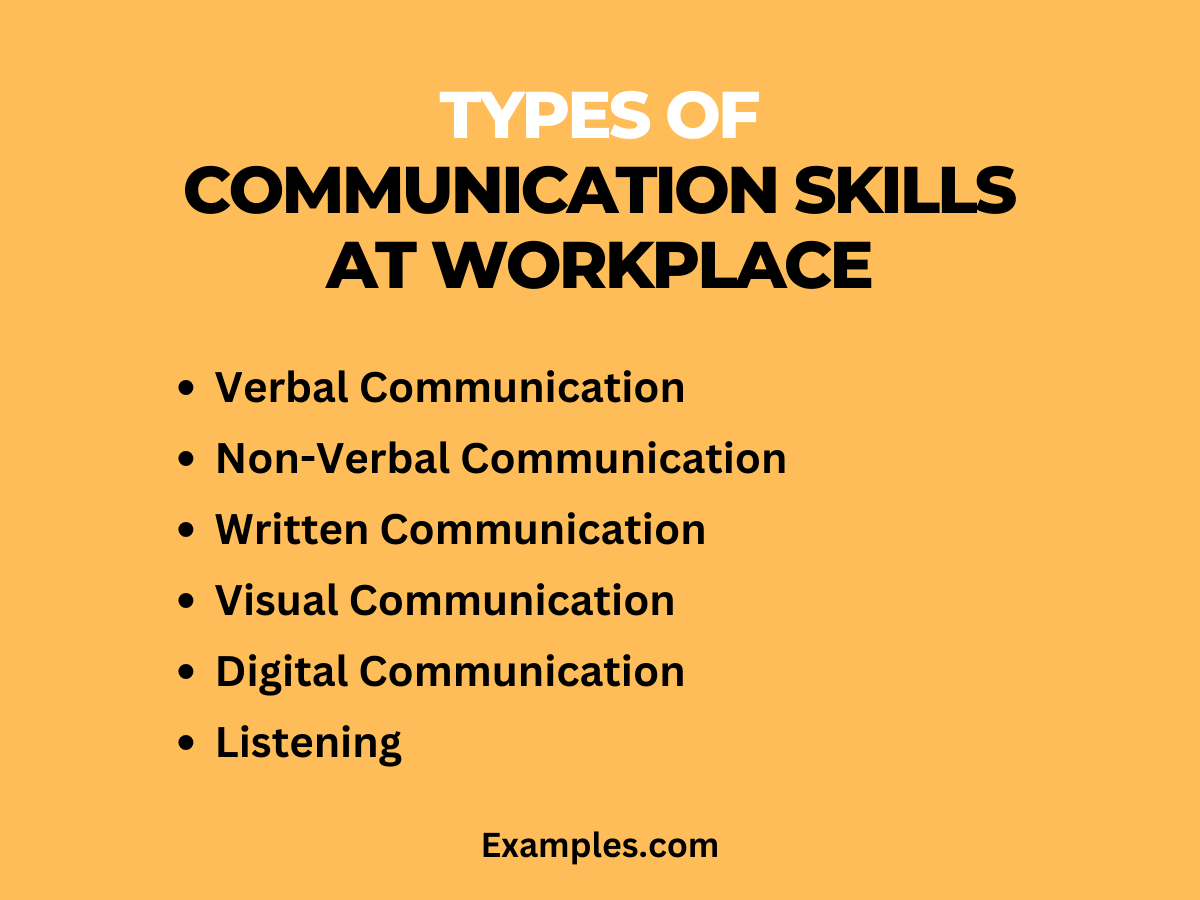
Verbal Communication
- Face-to-Face Meetings: Direct interaction that allows for immediate feedback and clarification.
- Telephone Conversations: Useful for quick discussions or when in-person meetings aren’t feasible.
Non-Verbal Communication
- Body Language and Gestures: Non-verbal cues that can complement or contradict verbal communication.
- Facial Expressions: Can convey emotions and reactions, adding depth to verbal messages.
Written Communication
- Emails and Memos: Common for formal and official communication.
- Reports and Documents: Essential for detailed and structured information sharing.
Visual Communication
- Charts and Graphs: Useful for presenting data in an easily digestible format.
- Slideshows and Presentations: Effective for sharing information in meetings and conferences.
Digital Communication
- Social Media: Increasingly used for informal communication and networking.
- Collaboration Tools: Platforms like Slack and Microsoft Teams facilitate team collaboration and project management.
Listening
- Active Listening: Involves fully concentrating, understanding, and responding to what is being said.
- Empathetic Listening: Understanding the speaker’s perspective and empathizing with their situation.
In conclusion, effective communication in the workplace is multi-faceted, encompassing various types and forms. It’s essential for the smooth functioning of any organization and plays a significant role in employee satisfaction, productivity, and professional growth. By developing and employing these skills, individuals can contribute positively to their work environment and career progression.
What are the Benefits of Communication Skills at Workplace?
Effective communication skills in the workplace offer numerous benefits that contribute to the overall success and harmony of an organization. These skills are crucial for creating a productive, efficient, and positive work environment.
Enhances Team Collaboration
- Improved Teamwork: Clear and open communication fosters better collaboration among team members.
- Efficient Problem-Solving: Teams with good communication resolve issues more effectively and quickly.
Boosts Employee Morale
- Positive Work Environment: Effective communication contributes to a more positive and inclusive work atmosphere.
- Employee Satisfaction: When employees feel heard and understood, it leads to higher job satisfaction.
Increases Productivity
- Clarity in Tasks: Clear communication ensures everyone understands their roles and responsibilities, reducing confusion and errors.
- Time Efficiency: Effective communication minimizes misunderstandings, leading to more efficient task completion.
Aids in Conflict Resolution
- Effective Dispute Management: Good communication skills are essential for resolving workplace conflicts amicably.
- Promotes Understanding: Understanding different perspectives through communication helps in finding common ground during disagreements.
Enhances Professional Relationships
- Stronger Work Relationships: Respectful and empathetic communication strengthens relationships between colleagues.
- Networking Opportunities: Good communication skills can also lead to better networking and professional opportunities.
Drives Better Decision Making
- Informed Decisions: Effective communication ensures all necessary information is shared, leading to more informed decision-making.
- Diverse Perspectives: Open communication encourages sharing different viewpoints, enriching the decision-making process.
How to Improve Communication Skills in the Workplace?
Improving communication skills in the workplace is essential for creating a more efficient, collaborative, and positive work environment. Effective communication leads to better teamwork, problem-solving, and overall workplace harmony. Here are some practical tips to enhance your communication abilities in a professional setting.
Practice Active Listening
- Full Attention: Give your full attention to the speaker, avoiding distractions. This shows respect and helps in understanding their perspective better.
- Feedback: Provide feedback by summarizing or asking clarifying questions to ensure you have understood the message correctly.
Develop Clear and Concise Messaging
- Clarity: Be clear and specific in your communication to avoid misunderstandings.
- Brevity: Keep your messages brief and to the point to maintain the attention of your audience.
Enhance Your Non-Verbal Communication
- Body Language: Use positive body language such as nodding and maintaining an open posture to convey engagement.
- Facial Expressions: Be mindful of your facial expressions as they can greatly impact how your message is received.
Foster an Open Communication Environment
- Encourage Sharing: Create an environment where team members feel comfortable sharing ideas and opinions.
- Respect Different Opinions: Show respect for different viewpoints, fostering an inclusive atmosphere.
Give and Receive Feedback Constructively
- Constructive Criticism: Offer feedback in a constructive manner, focusing on actions rather than personal attributes.
- Receptiveness: Be open to receiving feedback and use it as an opportunity for growth.
Adapt Communication to Your Audience
- Audience Awareness: Tailor your communication style to suit the preferences and understanding level of your audience.
- Cultural Sensitivity: Be aware of cultural differences and adapt your communication accordingly.
Utilize Technology Effectively
- Digital Tools: Leverage emails, instant messaging, and video conferencing tools effectively for clear and timely communication.
- Digital Etiquette: Maintain professionalism in digital communications, just as you would in face-to-face interactions.
Improve Written Communication Skills
- Professional Writing: Ensure your written communications are clear, professional, and free of errors.
- Email Etiquette: Use clear subject lines and get straight to the point in emails to ensure your message is understood.
Regularly Review and Reflect on Your Communication
- Self-Assessment: Regularly reflect on your communication skills and identify areas for improvement.
- Seek Feedback: Ask for feedback from colleagues and superiors to gain insights into your communication style and effectiveness.
Engage in Continuous Learning
- Professional Development: Take advantage of workshops, seminars, and training sessions to enhance your communication skills.
- Stay Informed: Keep up-to-date with the latest communication trends and best practices in your industry.
By implementing these tips, you can significantly improve your communication skills in the workplace, leading to better collaboration, increased productivity, and a more harmonious work environment. Effective communication is key to professional success and should be continuously developed and refined.
In conclusion, honing communication skills at the workplace is pivotal for professional success and a harmonious work environment. Mastery in both verbal and non-verbal communication, coupled with empathy and adaptability, lays the foundation for effective teamwork, conflict resolution, and strong workplace relationships. Investing time in developing these skills is indispensable for career growth and fostering a productive, collaborative, and respectful professional setting.



